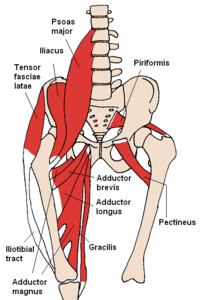
Photo from wikipedia
Background: Free functioning muscle transfer is a reconstructive option to restore elbow flexion in brachial plexus injuries. The authors determined the impact of body mass index, age, and location of… Click to show full abstract
Background: Free functioning muscle transfer is a reconstructive option to restore elbow flexion in brachial plexus injuries. The authors determined the impact of body mass index, age, and location of distal tendon attachment on elbow flexion strength after free functioning muscle transfer in traumatic brachial plexus injury patients. Methods: A retrospective review of patients who underwent free functioning muscle transfer for elbow flexion as part of their brachial plexus injury reconstruction with a minimum 2-year follow-up were evaluated. Outcomes assessed included elbow flexion strength (British Medical Research Council grade) and change in Disabilities of the Arm, Shoulder and Hand questionnaire and visual analogue scale pain scores. Results: One hundred six patients met inclusion criteria. The average age was 32 years, and the average body mass index was 27.1 kg/m2; 56.5 percent of patients achieved M3 or greater muscle grade using the authors’ strict modification of the British Medical Research Council scale. Disabilities of the Arm, Shoulder and Hand questionnaire scores improved from 45.7 to 38.8 (p < 0.05). Visual analogue scale pain scores decreased, but this trend did not obtain significance. Age and body mass index both had a significant negative impact on final free functioning muscle transfer grade (p < 0.05). Use of a distal tendon insertion led to improved muscle grade outcomes, with targeting of wrist extension being superior to finger flexion (p < 0.05). Simultaneous musculocutaneous nerve grafting did not significantly alter final elbow flexion strength. Conclusions: Increasing age and body mass index both imparted a deleterious effect on free functioning muscle transfer muscle grade. Distal muscle targets had better strength outcomes than when the biceps tendon was used. CLINICAL QUESTION/LEVEL OF EVIDENCE: Risk, III.
Journal Title: Plastic and Reconstructive Surgery
Year Published: 2022
Link to full text (if available)
Share on Social Media: Sign Up to like & get
recommendations!